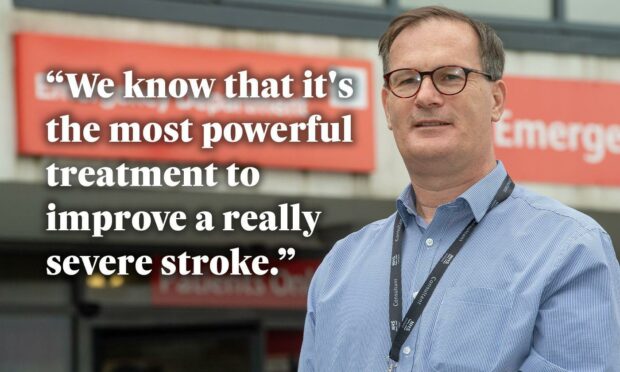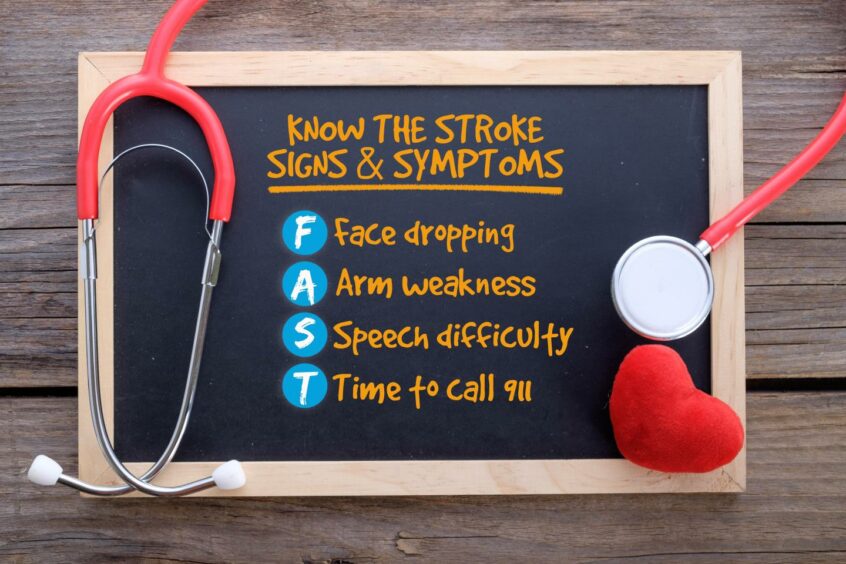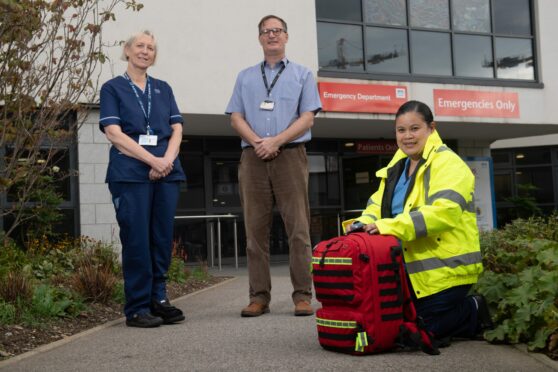Patients in Grampian can now get access to a life-changing procedure after suffering from a severe stroke.
Recovering from a stroke can be a devastating experience for survivors with up to two-thirds leaving hospital with a disability.
The injury to the brain can lead to widespread and long-lasting problems with some patients left with paralysis or speech loss.
However, a new service is now being rolled out which can help prevent the worst outcomes for those who have suffered the most severe types of strokes.
And one patient from the region has already benefitted from the thrombectomy procedure since the pilot was launched.
‘It can vastly improve the outcome for stroke sufferers’
Lead clinician at Aberdeen Royal Infirmary John Reid said evidence has shown that the procedure can “vastly improve” the outcome for patients.
“We know that it’s the most powerful treatment to improve a really severe stroke,” he said.
What is a thrombectomy?
A stroke happens when the blood supply to part of the brain is cut off. This prevents the brain tissue from getting vital oxygen and nutrients and brain cells begin to die.
However, the thrombectomy procedure can now be used to remove blood clots to help restore the patient’s blood flow.
It involves a specialist clot removal device being inserted through a catheter to pull out the clot.
The procedure can remove clots that are too big to be broken down by clot-busting drugs so is effective in preventing and reducing long-term disabilities.
Why can only around 10% of stroke patients have the treatment?
Only around 10% of patients will be eligible for the treatment.
This is because it can only be used on patients with blockages in large blood vessels due to the size of the tools involved.
Drugs are normally used to help break up or dissolve clots in smaller blood vessels.
Dr Reid says research trials for the relatively new treatment have shown very positive results.
“This type of stroke for most people has a devastating outcome,” he said. “Many don’t survive, or if they do survive they are severely disabled.
“And what the research trials show is the proportion of people who get back to independent living is much higher than they were at 50%, compared to 10 or 20%.”
Why will patients need to get to hospital as soon as possible for the procedure?
NHS Tayside introduced the pilot mechanical thrombectomy service in November 2020, which was the first of its kind in Scotland.
The treatment has just opened up to patients living in Grampian.
But patients will still need to travel down to Ninewells Hospital in Dundee for the procedure because there’s currently not enough trained doctors to provide the service.
Research trials have shown the patients should undergo the life-changing procedure within six hours of having a stroke.
This means the patient will need to be taken to Aberdeen Royal Infirmary as soon as possible for a brain scan to determine whether they are eligible.
If they are they will be transported down to Ninewells Hospital in an ambulance for the thrombectomy procedure.
Dr Reid explained why it’s vital that the treatment was carried out within a few hours of the patient having the stroke.
“The longer the blood vessel remains blocked the area of brain tissue that’s deprived of this blood supply progressively dies,” he said. “And the longer that blood vessel remains blocked the more brain tissue dies, the worse the stroke is, the more permanent that disability is.”
The treatment is a ‘major improvement’ for stroke patient care
So far 13 patients from the Tayside and Grampian areas have had the treatment which is currently still in the pilot phase and only available on weekdays.
Dr Reid hopes that in the future the procedure will also be available at Aberdeen Royal Infirmary.
He says its one of the most exciting developments for stroke sufferers he’s encountered during his medical career.
It is an important development with an estimated 15,000 people in Scotland having a stroke each year.
“To see any major improvement like this is a real advancement, and what can be done to help people,” he said.
“It’s important that people are aware of it.
“We are delighted patients in Grampian will be able to benefit from this pilot.”
‘It’s an astonishing procedure’
John Watson, Associate Director for the Stroke Association in Scotland decribed it as “very good news” for patients in Aberdeen.
He added: “For patients who are eligible, it’s no exaggeration to say that some will now have a future without disability as a result of this astonishing procedure being available to them.
“Around one in every three people who receive a thrombectomy after their stroke will be less disabled as a result.
“Around one in five will be able to function completely independently afterwards.”
More health news…
Meet the man who has helped thousands of people improve their lives after losing his eyesight
Changes to GP surgeries brought in during pandemic will improve patient care
How to cope with work stress when you feel like you need a new job
Young woman cried nearly every day after becoming dependent on feeding tubes




